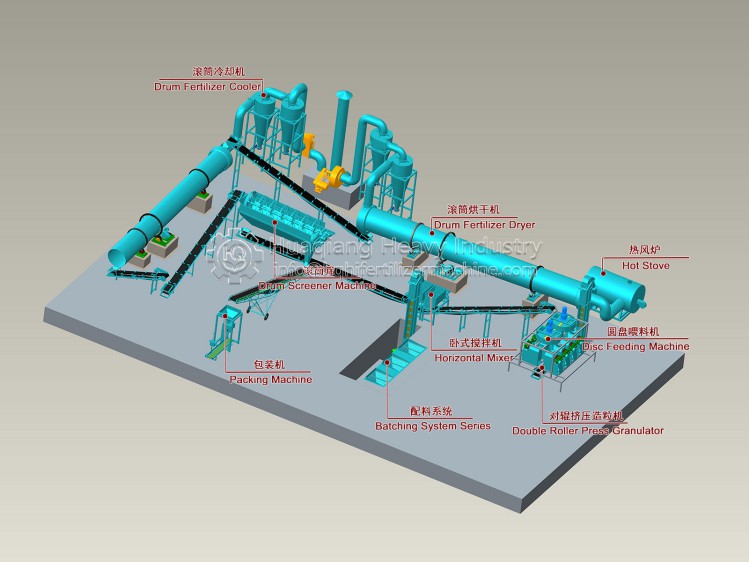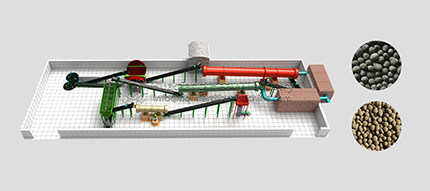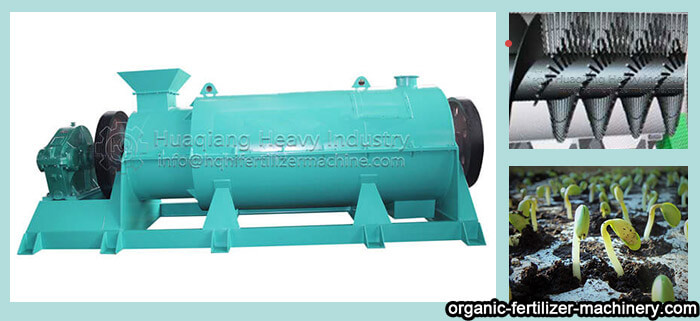
Model Selection of Organic Fertilizer Granulator
The difference in the selection of organic fertilizer granulator models lies in the selection of appropriate granulation methods according to the use requirements of materials. This is just a big general term. There are subdivisions and branches under it. It is mainly divided into dry method and wet method:
Dry process mainly refers to products with relatively low water content. Generally, water content below 10% is a zero limit. (There are also few materials that can reach 16%, for example, some materials only carry crystal water.) Most of the particles produced by dry granulation are irregular particles (for example, ordinary granular potassium fertilizer) or the more common shape is similar to small gravel. With the current industrial upgrading and increasingly strict environmental protection requirements in China, many chemicals and building materials need granulation.
The main index of wet granulation is the material with a water content of more than 20%. There are various equipment and methods for wet granulation. For example, disc granulation, drum granulation and spiral granulation have been carried forward many years ago, and have been greatly improved by increasing the use environment and processing requirements of different materials. For example, the particle size of relatively popular organic fertilizers over the years ranges from 1mm to 6mm. These methods were adopted.
Compared with wet granulation, dry granulation in organic fertilizer granulator consumes less energy, is more environmentally friendly, does not require drying, does not add water and binder, and does not change the properties of materials; Compared with wet granulation, these are also several advantages of dry granulation. It is more suitable for industrial production.
In another case, some materials require relatively small particle sizes. Products between dozens of meshes and 100 meshes can also be reduced by airflow, spray and rapid drying.
The reason of raw material precipitation during npk fertilizer granulation
When some compound fertilizer equipment production lines are processed by rotary drum granulator, they can dissolve the fertilizer into a certain proportion, but if the energy exceeds a certain amount, it will produce salt analysis and precipitate another substance.

Mixing equipment in NPK fertilizer production process
In NPK production line, blender will be used to mix materials. Here is a brief introduction of screw blender.

Structure of screw mixer
How to realize granulation of fertilizer by organic fertilizer granulator
New type organic fertilizer granulator, that is, the stirring tooth drum granulator, is widely used in organic fertilizer production line. The new type organic fertilizer granulator adopts agglomeration granulation process to make organic fertilizer raw materials into granules, which is convenient for transportation and use of organic fertilizer. It’s core in organic fertilizer production equipment. The equipment has been welcomed by the vast number of organic fertilizer plants.
Structure of New Type Organic Fertilizer Granulator

New type organic fertilizer granulator is powered by the motor, which drives the granulating shaft to rotate at high speed through a reducer or belt drive. The new type organic fertilizer granulator only needs a power device to make the high humidity material granular from powder. The core components of the new type organic fertilizer granulator are the granulating shaft and the spiral blades and agitating teeth on it, which are arranged in the same order on the axis. The height of the stirring teeth can be adjusted effectively by connecting the stirring teeth and the stirring rods with threads. The more the stirring rods are arranged, the better the granulation effect is, but the more the stirring rods at the front end will cause blockage, so the stirring rods arranged in a certain way will have a better effect. The diameter of organic fertilizer granules produced by the new type organic fertilizer granulator is usually 0.3-5 mm. The granulation rate of the granulator is higher than 85% and the yield is higher.
Features of Wet Organic Fertilizer Granulator
Application of Dumper in Organic Fertilizer Production Line
Windrow turner is a kind of walking compost turning machine. There is no need to build fermentation tank in the process of organic fertilizer fermentation, which can effectively reduce infrastructure investment and increase land utilization.
The turning machine is widely used in the dumping and fermentation of various materials (livestock manure, sludge filter, straw, slaughterhouse waste, edible fungi, etc.). The material after fermentation is suitable for pelleting by rotary drum granulator.

Characteristics of compost turning machine
Huaqiang fertilizer equipment factory provides a variety of composting equipment, organic fertilizer production process, NPK production line, fertilizer manufacturing machinery.
Process of organic fertilizer production line for sludge and feces treatment
Fertilizer based on waste and bio organic residues. Its types are: domestic garbage; Domestic sewage; Abattoir waste; Marine fertilizer (local fertilizer consisting of animals, plants or minerals in coastal areas). Organic fertilizer contains a large amount of nutrients required by plants, providing a mild and lasting nutrient supply for plants, and has long-term aftereffects. Organic fertilizer also contains a variety of trace elements. Because all kinds of nutrient elements in organic fertilizer are complete, and these substances are completely non-toxic, harmless and pollution-free natural substances, this provides the necessary conditions for the production of high-yield, high-quality, pollution-free green food. Organic fertilizer contains many kinds of sugars, and the application of organic fertilizer increases many kinds of sugars in the soil. With the large amount of energy released by the degradation of sugar and organic matter, there is energy for the growth, development and reproduction of soil microorganisms.
Ten processes of sludge organic fertilizer production line
1、 Stack the strips on the ground, use the ground stacker, or put the materials into the fermentation tank, and use the trough dumper
2、 Evenly spray the organic fertilizer starter, turn over and ferment, to achieve the purpose of warming up, deodorizing, decomposing and killing miscellaneous bacteria and grass seeds
3、 The fermentation lasts for 7-12 days. The number of revolutions varies according to the temperature in different places
4、 Completely ferment and decompose, and leave the tank (the ground type is directly collected by forklift)
5、 Use grading screen to screen the thickness (the screened powdered fertilizer can be sold directly)
6、 The screened large blocks are crushed by a crusher and returned to the grading screen
7、 Mix the required trace elements with the pre mixer
8、 Granulation with organic fertilizer granulator
9、 Entering dryer and cooler
10、 Automatic packaging machine packaging for sale
How to improve the pelletizing rate of NPK fertilizer production
NPK compound fertilizer is characterized by simple composition, high nutrient content, low dosage, quick fertilizer effect, convenient application, transportation and storage, and rapid improvement of yield and quality. In order to produce large quantities of high-quality compound fertilizer, the first step is to produce good fertilizer granules.
The main factors influencing NPK fertilizer production line are as follows:
- Production equipment;
- Process technology;
- Physical and chemical properties of raw materials;
- Production formula and added conditioner;
- Air temperature and air volume at the outlet of the dryer;
- Temperature and liquid phase quantity of granulating materials;
- Material flow;
- Material return ratio;
- Quality of operators;
- Climatic conditions.
Only by integrating the above factors into making fertilizer granules, can we produce NPK fertilizer with high yield and good quality, one of which is indispensable.

- Improving the performance of NPK fertilizer production equipment is the basis
Choose qualified production equipment, choose well-equipped, complete test means, reliable product quality manufacturers, under the guidance of experienced personnel to buy, late equipment management and maintenance personnel to have a certain professional level. Zhengzhou Huaqiang Co.Ltd are leading agricultural fertilizer machine manufacturers in China. We has strong technical strength in fertilizer machines. All of our products comply with international quality standards and greatly appreciated in a variety of different markets throught the world.
- Choosing ammonium phosphate with good viscosity as raw material is the premise
The pelletization of NPK fertilizer mainly depends on the viscosity of ammonium phosphate and conditioner, and the poor viscosity of ammonium phosphate directly affects the pelletization rate of compound fertilizer. Therefore, when purchasing ammonium phosphate, we should consider not only nutrient content and price, but also its viscosity. From the actual production experience, the viscosity of diammonium phosphate is better than that of monoammonium phosphate.
- Ensuring the fineness of raw materials and feedbacks is essential
The finer the powder of the raw material, the better the viscosity of the material, the more important it is to improve the efficiency of the crusher
Chain crusher to help make the big granules into the fine powder and get back to fertilizer granulator machine. It is simple and compact in structure, cover small area, easy maintenance such characters, crushing effect is good, smooth operation, easy to clean.
- Material mixing is an important measure to improve the NPK fertilizer production line efficiency
The material is mixed evenly, on the one hand, the mixer mixes the fresh material evenly, on the other hand, the mixer combines the returned material and the fresh material evenly. Because the fine powder in the returned material is mostly potassium and nitrogen with poor viscosity, it is the material that is least likely to form into a ball, while the fresh material has better viscosity and is easy to form into a large ball in production. Mix the two thoroughly to prevent the formation of large balls and too much powder.
- Suitable moisture and pelletizing temperature are the key
Only when the temperature and water content of granulating materials are adjusted to the optimal point can the granulation area be ensured to be normal.
The disc fertilizer granulator is suitable for the production with small yield, and the rotary drum granulator is suitable for the mass production of NPK fertilizer. Addition of moisture during granulation requires certain experience of operators.
- Suitable air volume and stable furnace temperature are the preconditions
The size of the air volume directly affects the drying effect, the air volume in the dryer, the drying effect is good. If the air volume is too large, it is easy to extract the powder in the simplified body, and the wind speed should be less than 2m/s.Best cooling head end temperature difference is about 100℃, the import and export temperature cannot frequent adjustment. When urea is used as nitrogen source, the temperature should be determined according to the amount of urea. The more urea is used, the lower the drying operation temperature will be.